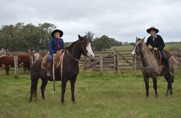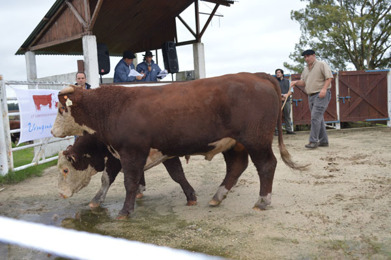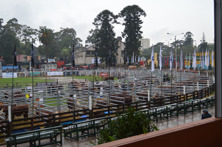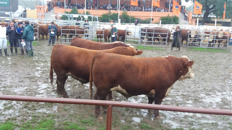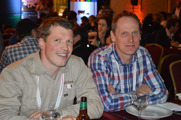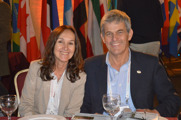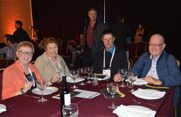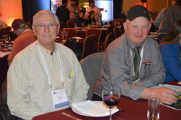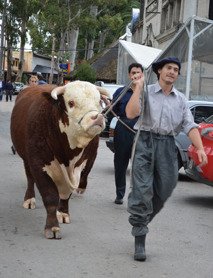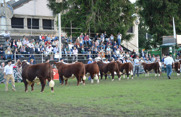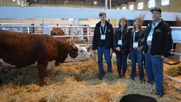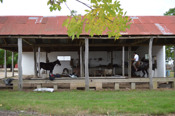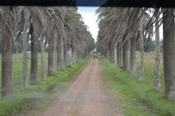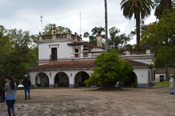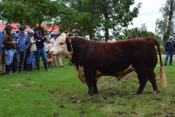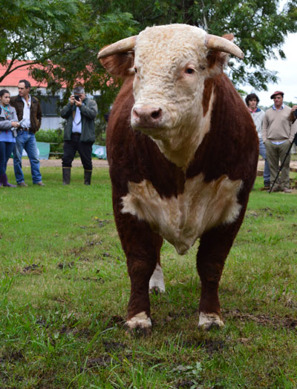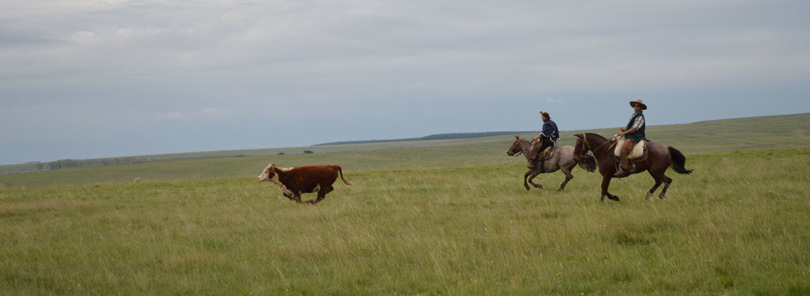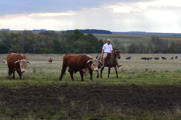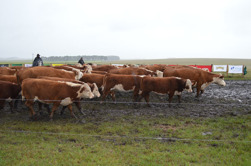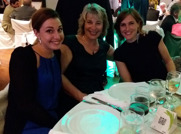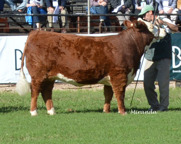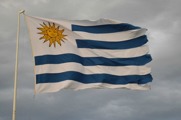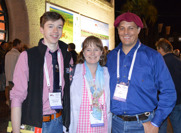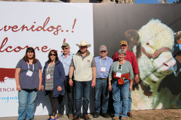

The 17th World Hereford Conference
By Miranda Lysell
Secretary of the Swedish Hereford Association and web Coordinator for WHC.
The World Conference is held every fourth year. This, the 17th World Hereford Conference was held between the 18th and 25th of April 2016 in Uruguay. A country of just over 176,000 square kilometres (almost 110.000 square miles) and with a population of only 3.4 million. Uruguay shares borders with Brazil to the north and Argentina to the south west. 80% of the land is used for producing beef. The countries main income is tourism closely followed by beef production. 70% of all beef produced is exported and the rest is consumed within the country where average consumption per capita is about 60-65kg per year.
Crops that are produced are Sorgum, Maize and Soya (99% of all Soya is exported to China) Soya is bar far the crop mostly produced. They don’t plough or re-seed pastures in the same way as we do in Europe.
The cattle eat grass, even winter time. Some pedigree herds will feed bull calves with sire potential, Sorgum and maize which is also fed at feedlots. Just so that the potential sires, are fit and ready to breed cows at 1½ years of age and also in order to compete with other herds for their 15 month weight. Most bull calves are castrated but I have heard that only 10-12% of all steers are finished in feedlots and it is only mainly steers that are meant for the European market that are finished in this way (according to General Secretary José Bonica) otherwise cattle are finished on grass only.
The farmers receive 3USD per kilo for young stock and 2.60USD per kilo for older cattle, from the abattoir. This is the lowest price in over 10 years.
Meat, wool and cellulose, forest and wind power is what is produced in Uruguay. There are no other main industries. Everything else like machinery, textiles and oil are imported.
The conference week.
You can say that we had luck and bad luck with the weather. Beautiful in Buenos Aries, (where I spent the first couple of nights), the ferry to Montevideo, and the morning of the first day in Piriapolis (where I spent a couple more nights,) but after that it was mainly really bad thunderstorms, torrential down pour and lighter rain. Upon arriving to my hotel in Montevideo I decided I had to go to the shopping centre which was only a quick walk away, to buy a pair of wellies. The wind was blowing so hard that I could hardly keep on my feet. Later I heard that there had been a cyclone about 300km away.
Conference day one, Monday the 18th of April
The first day included a visit to the performance testing station, Kiyú in the region of San José, from where 1250 people were evacuated due to flooding. The annual average rainfall in Montevideo is 950mm or 37.4 inches. Four months rain had fallen within the last four
days, causing flooding in the south of Uruguay.
At the performance testing station there were 120 bulls from 40 herds (three bulls per herd). They are tested for feed efficiency and carcase traits and they get linear scored. The bulls are 10 months of age when the test begins and the first part is the feed efficiency test which lasts for 100 days. They are fed in GrowSafe containers which weighs the amount of feed eaten. The feed consists of Sorgum and Maize. After the end of the trial, two of the bulls from each herd are sent home and one stays and takes part in the daily gain on grass, test. For more information about the test station, visit their website; http://www.hereford.org.uy/hereford/central-kiyu/central-y-uso-del-suelo The pages are in Spanish, but you can translate them to English with a right click on your mouse, depending on which browser you have.
After the visit at the test station we were to visit another farm, but it was cancelled because the farm, or roads to get there, were flooded. Instead we went for a sneak preview of the national showground, Rural del Prado about 10km or 6 miles from our hotels, where we would spend the next few days.
Conference day 2, Tuesday the 19th of April
The Rural del Prado was pretty impressive, with three halls built of stone two of which housed the cattle, and one was being used at the moment as the conference hall. There were also restaurants, a café a couple of shops including one selling the Hereford Associations merchandise (they sold a lot of umbrellas!). There was one main ring, with one main grand stand. Because today was the Pen show, there were boxes around one side of the ring, built from portable panels. Across the other side of the ring there were permanent stable blocks where the Criollo Horse, Appaloosa and American Quarter Horse Associations had their headquarters. I have to admit that I didn’t follow the pen show very well, because it poured down all day and my little umbrella was breaking… I have to mention though that a pen of ET bulls from Norway won their class. They were from Birkeli Herefords which is so far north that it is within the Arctic Circle. Both sire and sire of dam are Norwegian AI sires.
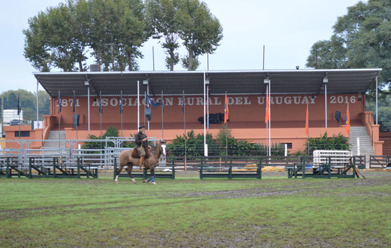
Day three, Wednesday the 20th.
Day three was the day of the official WHC meeting. (For those not taking part in the meeting there were interesting lectures) I was the only official delegate from Sweden, being the secretary and only board member of our association at the conference.
One thing that country delegates voiced an opinion about was the website and lack of communications. To make a long story short, we had three WHC meetings over the course of three days. This resulted in one, indefinite, genetic committee and one definite communications committee, which will include José Bonica (Secretary General for the WHC) David Deakin, and myself. I’m proud to announce that I have done the new website for the WHC as well as a Facebook page. It is important that the World Hereford Council keeps up with today’s social media and takes advantage of the important role it plays in gaining publicity.
I must not forget to mention that the country reports took place on the afternoon of the first WHC meeting. Here, the country hosting the 18th World Hereford Conference was reviled; NEW ZEALAND!
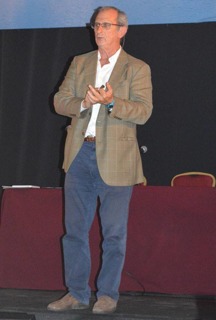
Day four, Thursday the 21st
Lecture day. There were several very interesting lectures throughout the day, the last one was on quite an unexpected topic, but I must say a very pleasant surprise and one that I will never forget. “Managing Adversity” by speaker, Gustavo Zerbino who was one of the survivors of the plane crash in the Andes in 1972. Some of you may have seen the film “Alive” which is based on the true story, about the crash in the Andes. After hearing what Gustavo Zerbino went through, the way he looks at life, the way he thinks everyone should look at life, as well as showing a few parts from the film, left many of us in tears.
This day ended with gala sales and dinner. Unfortunately I didn’t have my sale catalogue with me back home. But, there were approximately 10 animals sold at the sale. There was a 20 month old heifer by NJW Home Town that had caught my eye in the cattle sheds, Mamia Homethown. She was deep, thick, feminine, had great feet and legs. You really couldn’t fault her. She was the kind of heifer that gave you goose bumps! And the audience liked her to, as half of her was sold for the highest price of the evening, 7,200USD.
Below are a few photos from the gala sales and dinner. Click on them to enlarge. (Photo of Mamia Homethown further down the page)
Day five, Friday the 22nd.
Despite so many meetings, we did get to see the polled show on the fifth and last day of the conference week. I wish I could have had time to see the horned show, but the weather was beautiful, so never mind.
I was impressed with how well the cattle were fitted out and with the high level of showmanship. I thought that some of the cattle were slightly too high in condition, but you can’t feed certain things, like for instance; frame, depth of body, length of hip, the set of hip to pin, leg angles, udder and teats.
Named Grand Champion male was Ancares Kamikaze, a two year old with Star Bright Future 533P ET and CS Boomer in his pedigree. Grand Champion female was, not unexpectedly, Mamia Homethown. After the show, which took longer than planned, it was soon time for the gala dinner. I can say that I have definitely never gotten ready to go out so quickly before, nor have I been to such dinner smelling of cows before… (!)
Below are a few photo's from the show. Click on them to enlarge.
Post tour
I chose to go on Post Tour A, because I have been friends on Facebook for quite some time with one of the herds we were visiting, Las Anitas, which was the first stop on our tour and about 3½ hours north of Montevideo. They had a fair few cattle at the show in Prado. Over the last 15 years, the herd has claimed no less than 11 Grand Champion titles, of which Ancares Kamikaze is one of them.
I remember David Deakin telling me that he hoped to see cowboys (called Gauchos in South America) working with cattle one day… During the tour we certainly saw a lot of that! Beginning at Las Anitas where they breed Polo ponies and use them on the ranch, working cattle. As many of you know, Polo is very popular in South America as well as in England. Many polo ponies are exported from South America, especially from Argentina, to the UK.
There are 1500 commercial and registered mother cows at Las Anitas, both horned and polled. First we were shown the cattle that they showed at Prado. Then, the 20 Gauchos helped bring group after group of cattle into a paddock. They cut out a couple at a time from the group and owner Fernando told us about them and what he appreciated with them.
The cattle were slightly lower frame score than I am used to seeing here in Scandinavia, and even in the UK. Fernando told me that 80% of the Uruguayan breeders weigh their calves and that the breeding evaluation is in the PAN American EPD system.

The average weights at Las Anitas:
BW 38kg WW 220kg, 15 months 550kg.
Average weights for the country:
Birth weight:
Bull calves 36.4 kg Heifer calves: 34.9 kg
Weaning Weight;
Bulls 195.9 kg Heifers 183.9 kg
15 months weight;
Bulls: 376.5kg Heifers: 271.7 kg
Post tour day two
El Paraiso
On the second day of the tour, we visited two farms or ranches if you like. El Paraiso and El Baqueano, both owned by the Borderberry family. We visited El Paraiso first. The farm had 3500 hectares of land + 700 hectares on lease. 1200 mother cows of which approx. 200 registered and the rest commercial, both horned and polled. The coaches stopped in the middle of nowhere it seamed with nothing but Pampas as far as the eye could see. I wasn’t really sure why we’d stopped, but we got off anyway. But suddenly a large herd of red and white cattle appeared, driven to us by Gauchos. What a sight! The weather was actually behaving to. Despite this being part of the commercial herd (we were shown a couple of groups here) there were some really nice cows and calves. We got back on the busses and dove up to the farm through a beautiful alley of Palm trees. The farm house was also very beautiful with heaps of character, and there were a few older buildings. There were some cows with quite young calves in pens for us to look at. The cattle here I thought were larger frame score than the cattle I’d seen earlier. Even here, we got to see group after group – I’m not sure how many animals in total. Even here we got to see the cattle that they had shown in Prado, among them was the impressive Paraiso Lucifer who was Senior Champion.

El Baqueano
After lunch we jumped into mini busses for the short drive to El Baqueano. The farm has about 2800 hectares of land with 600 commercial cattle and 350 registered cattle, all of which are horned. Steers are finished on grass and are slaughtered at 2 years with a carcase weight of 450-480 kilos. Cull cows are finished with a carcase weight of 480-500kg.
The ranch also breeds Corridale sheep and are in a breeding program for them. Even purebred Criollo horses are bred here. The Criollo is the cow horse of South America. Once again, Gauchos brought group after group of cattle to us, over the pampas as the sun was setting. It was truly a sight for sore eyes. Like something from a film! Once we had seen all the cattle, they brought up a herd of mares, foals and the stallion. I was surprised that the stallion didn’t bother about the Gauchos horses that were herding them.
I was lucky enough to be offered a ride on one of the horses that had been used for driving the cattle. A marque had been raised here, there was live music and on farm produced beef and lamb on the bar-b-que which we ate together with (far too much) locally produced red wine…

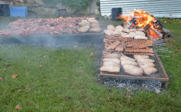
The last day
It had rained a lot during the night and in the morning it was uncertain if the roads would allow us to get to our last stop, it had turned quite cold to. But after our guide had talked to the people at the farm the decision was made in the end to give it a go. My friends from the UK were due to fly home later in the afternoon and didn’t want to chance missing their flight, so they decided not to go with us, but head back to Montevideo instead.
Well the roads, or tracks I should say, were not good. But we made it. The coach stopped suddenly and we got off. A parade of ladies and young girls on horseback in beautiful dresses, gauchos and two ladies in a horse drawn trap came to greet us in the rain. On the ranch they have 320 registered Herefords, both horned and polled as well as some Angus. Since 1959 the herd has earned 23 Grand Champion titles and many Reserves. In the spring of 2014, the 14,000th calf was tagged, and 10,000 bulls have been sold for breeding.

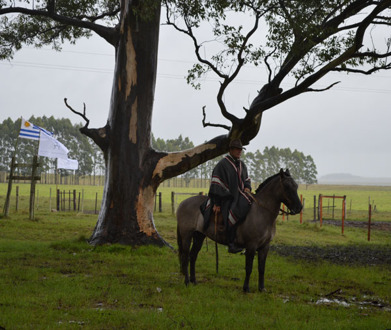
Going back, as we drove down the drive to the ranch, we saw the horses that the Gauchos had used, this time themselves loose and being driven back to their pasture by a couple of Gauchos.
As in all parts of Uruguay that we had been in, there was about 5-10 meters of grass verge on both sides of all the roads and tracks. These were used for herding cattle, riding, and closer to the towns, even for grazing horses tethered. We even saw the odd cow or two grazing in this way. We even saw horses grazed tethered on the grass in the middle of by-passes with two lanes in each direction…
The rain turned into down pour and the wind got up as we watched the gauchos bring group after group of cattle to us in a paddock on the farm. Most visitors stood in the marque about 20 – 30 meters away. There were only a hand full of (crazy) people stood next to the paddock under umbrellas – José Bonica and a couple of others under his, my friend Eva and one of her daughters, and me, juggling my new brolly and camera, in the hope of getting the perfect shot and trying to keep dry at the same time… mission (almost) impossible… I think I took the prize for being craziest or funniest act….
The rain eased just when it was time for them to show us the cattle they had with them at Prado. Among them was a beautiful heifer that they had bought at the Gala Sales, Alborada Homegrown who was a class winner and 3rd in the Grand Championship.
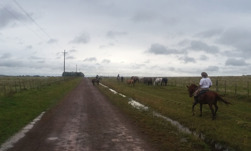

Surprise encounter…
After a very short, but well needed sleep, at a hotel close to the Montevideo Airport, my Swedish friends and I took an early morning flight to Sao Paolo where we had to wait a few hours for our connecting flight to London, (from where we would fly to Copenhagen followed by a short train journey across the bridge connecting Denmark and Sweden and on to my home town.)
Wandering about in the airport in Sao Paolo, I just couldn’t believe my eyes as Josh Dowbiggin from the UK came waving towards me…(!) He told me that the UK delegates had just missed their connecting flight to London yesterday as the flight from Montevideo to Sao Paolo had been delayed. They had had to stay overnight at a hotel in Sao Paolo and on my flight there was one seat available which Josh got and, the others were flying at midnight! A very unexpected encounter ended the 17th World Hereford Conference.
My sincere gratitude to the Uruguayan Hereford Association and hosts at farm visits for all efforts despite the terrible weather conditions.
Hope to see you all at the European Conference in 2018 in Hungary, if not before.
Your Swedish colleague and former UK resident, Miranda
Below are a few more photo's. There is room for more! I would like more photos, especially of people, cattle and anything else of interest. Please send them to the email adress at the bottom of the page. If you see yourself in any of the photo's or recognise anyone else, please email me with names!

